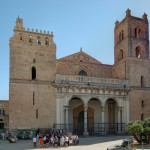 The Poseidon room, with the colors of the sea has everything you need for a perfect weekend of romance
The Poseidon room, with the colors of the sea has everything you need for a perfect weekend of romance
The relaxed atmosphere of the Gea room makes it the perfect place to accommodate the whole family.
Decorated with sunny shades of yellow, the room once again the charm of the god Phoebus and creates a cool and relaxing environment.
Palermo Cathedral is the cathedral church of the Roman Catholic Archdiocese of Palermo, located in Palermo, Sicily, southern Italy. It is dedicated to the Assumption of the Virgin Mary. As an architectural complex, it is characterized by the presence of different styles, due to a long history of additions, alterations and restorations, the last of which occurred in the 18th century.
History
The church was erected in 1185 by Walter Ophamil (or Walter of the Mill), the Anglo-Norman archbishop of Palermo and King William II’s minister, on the area of an earlier Byzantine basilica. By all accounts this earlier church was founded by St. Gregory and was later turned into a mosque by the Saracens after their conquest of the city in the 9th century. Ophamil is buried in a sarcophagus in the church’s crypt. The medieval edifice had a basilica plan with three apses, of which only some minor architectural elements survive today.
The upper orders of the corner towers were built between the 14th and the 15th centuries, while in the early Renaissance period the southern porch was added. The present neoclassical appearance dates from the work carried out over the two decades 1781 to 1801, and supervised by Ferdinando Fuga. During this period the great retable by Gagini, decorated with statues, friezes and reliefs, was destroyed and the sculptures moved to different parts of the basilica. Also by Fuga are the great dome emerging from the main body of the building, and the smaller domes covering the aisles’ ceilings.
Overview
The main façade is on the Western side, on the current Via Bonello, and has the appearance set in the 14th and 15th centuries. It is flanked by two towers and has a Gothic portal surmounted by a niche with a precious 15th-century Madonna. Two lintelled ogival arcades, stepping over the street, connect the façade to the bell tower in the front, annexed to the Archbishops Palace. This has a squared appearance adorned in the upper part by a fine crown of smaller belfries and small arcades.
The right side has outstretching turrets and a wide portico (the current entrance) in Gothic-Catalan style, with three arcades, erected around 1465 and opening to the square. The first column on the left belonged to the original basilica and the subsequent mosque, as testified by the Qur’an verse carved on it. The carved portal of this entrance was executed in the period 1426 to 1430 by Antonio Gambara, while the magnificent wooden leaves are by Francesco Miranda (1432). The mosaic portraying the Madonna is from the 13th century, while the two monuments on the walls, works of the early 18th century, represents King Charles III of Bourbon and Victor Amadeus II of Sardinia, the latter of which was crowned here with his wife Anne Marie d’Orléans in December 1713.
Built in 1143 at the behest of George of Antioch, Admiral of Roger II, the St. Mary’s church is also known as the “Martorana” because it was given in 1433 by King Alfonso of Aragon to the Benedictine monks of the nearby convent He founded by the noblewoman Eloisa Martorana. Despite the changes made in the sixteenth and seventeenth centuries (the Baroque façade is one example), this charming sacred building preserves its original Arab-Norman style as shown by the square body of the same topped by a hemispherical dome, and the bell tower open from arches and three rows of large windows. The inside of the church at the top of the walls, in the soffits and magnificent Byzantine mosaics in the dome considered the oldest in Sicily. central point of the whole mosaic decoration is the image of Christ Pantocrator surrounded by archangels, apostles, saints and prophets. Complete the cycle the mosaics with the Nativity of Jesus, Mary’s Transit, the Annunciation and the Presentation in the Temple.


















